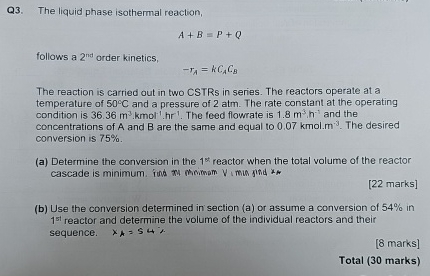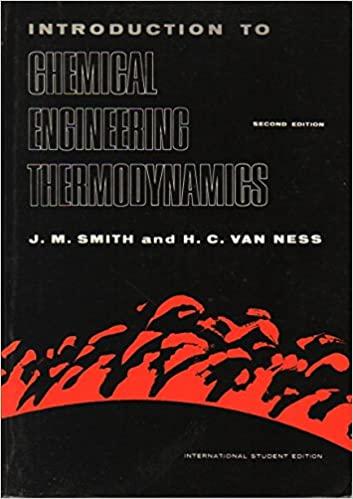Answered step by step
Verified Expert Solution
Question
1 Approved Answer
The liquid phase isothermal reaction. Total ( 3 0 marks ) A + B = P + Q follows a 2 n d order kinetics.
The liquid phase isothermal reaction.
Total marks
follows a order kinetics.
The reaction is carried out in two CSTRs in series. The reactors operate at a temperature of and a pressure of atm. The rate constant at the operating condition is The feed flowrate is and the concentrations of A and are the same and equal to kmol. The desired conversion is
a Determine the conversion in the reactor when the total volume of the reactor cascade is minimum. Tind nt minimam min prod
marks
b Use the conversion determined in section a or assume a conversion of in reactor and determine the volume of the individual reactors and their sequence.
marks
Total marks
Q The liquid phase isothermal reaction,
follows a order kinetics.
The reaction is carried out in two CSTRs in series. The reactors operate at a temperature of and a pressure of atm. The rate constant at the operating condition is The feed flowrate is and the concentrations of A and are the same and equal to The desired conversion is
a Determine the conversion in the reactor when the total volume of the reactor cascade is minimum. ind on menomam i min gith
marks
b Use the conversion determined in section a or assume a conversion of in reactor and determine the volume of the individual reactors and their sequence.
marks
Total marks

Step by Step Solution
There are 3 Steps involved in it
Step: 1

Get Instant Access to Expert-Tailored Solutions
See step-by-step solutions with expert insights and AI powered tools for academic success
Step: 2

Step: 3

Ace Your Homework with AI
Get the answers you need in no time with our AI-driven, step-by-step assistance
Get Started


